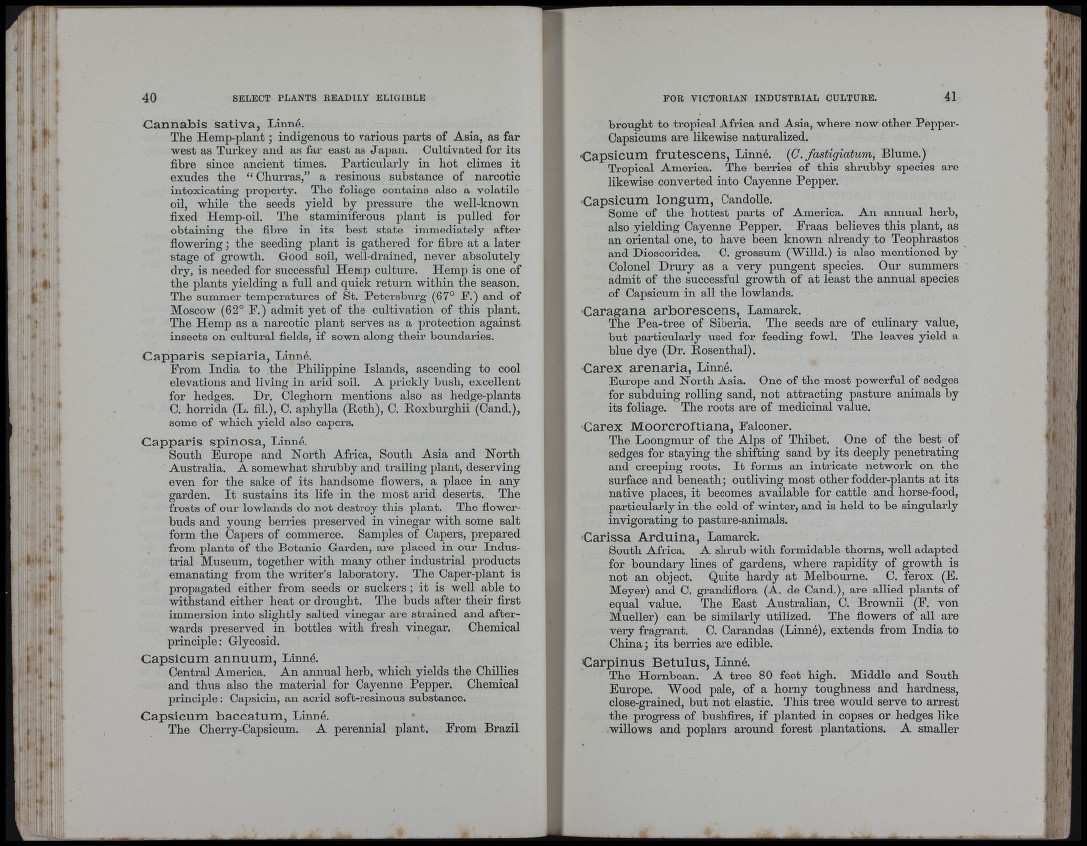
*
|! I
Cannabis sativa, Linné.
The Hemp-plant ; indigenous to various parts of Asia, as far
west as Turkey and as far east as Japan. Cultivated for its
fibre since ancient times. Particularly in hot climes it
exudes the “ Churras,” a resinous substance of narcotic
intoxicating property. The foliage contains also a volatile
oil, while the seeds yield by pressure tbe well-known
fixed Hemp-oil. The staminiferous plant is pulled for
obtaining the fibre in its best state immediately after
fiowering ; tbe seeding plant is gathered for fibre at a later
stage of growth. Good soil, well-drained, never absolutely
dry, is needed for successful Hemp culture. Hemp is one of
the plants yielding a full and quick return within the season.
The summer temperatures of St. Petersburg (67° F.) and of
Moscow (62° F.) admit yet of the cultivation of this plant.
The Hemp as a narcotic plant serves as a protection against
insects on cultural fields, if sown along their boundaries.
Capparis sepiaria, Linné.
From India to the Philippine Islands, ascending to cool
elevations and living in arid soil. A prickly bush, excellent
for hedges. Dr. Cleghorn mentions also as hedge-plants
C. hórrida (L. fil.), C. aphylla (Poth), C. Poxburghii (Cand.),
some of which yield also capers.
Capparis spinosa, Linné.
South Europe and North Africa, South Asia and North
Australia. A somewhat shrubby and trailing plant, deserving
even for the sake of its handsome fiowers, a place in any
garden. I t sustains its life in the mosb arid deserts. The
frosts of our lowlands do not destroy this plant. The fiower-
buds and young berifies preserved in vinegar with some salt
form the Capers of commerce. Samples of Capers, prepared
from plants of the Botanic Garden, are placed in our Industrial
Museum, together with many other industrial products
emanating from the writer’s laboratory. The Caper-plant is
propagated either from seeds or suckers ; it is well able to
withstand either heat or drought. The buds after their first
immersion into slightly salted vinegar are strained and afterwards
preserved in bottles with fresh vinegar. Chemical
pi'inciple: Glycosid.
Capsicum annuum, Linné.
Central America. An annual herb, which yields tbe Chillies
and thus also the material for Cayenne Pepper. Chemical
principle : Capsicin, an acrid soft-resinous substance.
Capsicum baccatum, Linné.
The Cherry-Capsicum. A perennial plant. From Brazil
brought to tropical Africa and Asia, where now other Pepper-
Capsicums ai-e likewise naturalized.
•Capsicum frutescens, Linné. {C. fastigiatum, Blume.)
Tropical America. The berries of this shrubby species are
likewise converted into Cayenne Pepper.
•Capsicum longum, Candolle.
Some of the hottest parts of America. An annual herb,
also yielding Cayenne Pepper. Fraas believes this plant, as
an oriental one, to have been known already to Teophrastos
and Dioscorides, C. gi'ossum (Willd.) is also mentioned by
Colonel Drury as a very pungent species. Our summers
admit of the successful growth of at least the annual species
of Capsicum in all the lowlands.
Caragana arborescens, Lamarck.
The Bea-tree of Siberia. The seeds are of culinary value,
but particularly used for feeding fowl. The leaves yield a
blue dye (Dr. Rosenthal).
Carex arenaria, Linné.
Europe and North Asia. One of the most powerful of sedges
for subduing rolling sand, not attracting pasture animals by
its foliage. Tbe roots are of medicinal value.
Carex Moorcroftiana, Falconer.
The Loongmur of the Alps of Thibet. One of tbe best of
sedges for staying the shifting sand by its deeply penetrating
and cx’eeping roots. I t forms an intricate netwox’k on the
surface and beneath ; outliving most other foddex’-plants at its
native places, it becomes available for cattle and Ixorse-food,
particularly in the cold of winter, and is held to be singulaxly
invigorating to pasture-animals.
Carissa Arduina, Lamarck.
South Africa. A shrub with formidable thorns, well adapted
for boundary lines of gardens, where rapidity of growth is
not an object. Quite hardy at Melbourne. C. ferox (E.
Meyer) and C. grandiflora (A. de Cand.), are allied plants of
equal value. The East Australian, C. Brownii (F. von
Mueller) can be similarly utilized. The flowers of all ai-e
very fragrant. C. Carandas (Linné), extends from India to
China; its berries are edible.
Carpinus Betulus, Linné.
The Hornbean. A tree 80 feet high. Middle and South
Europe. Wood pale, of a horxxy toughness and hardness,
close-grained, but not elastic. This tree would serve to ari-est
the progress of bushfires, if planted iix copses or hedges like
willows and poplars around forest plantations. A smaller